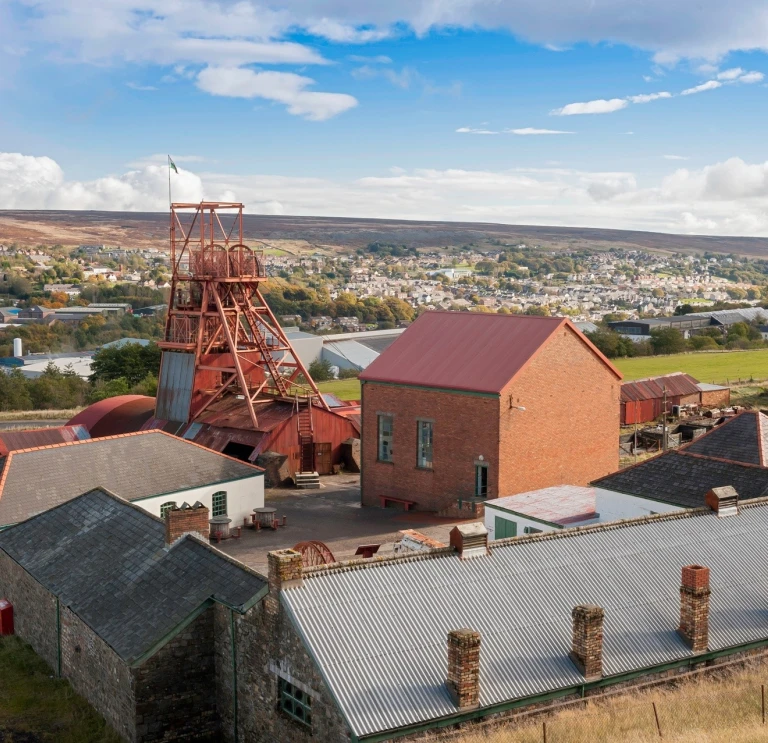Cyfarthfa Castle Museum & Art Gallery
Merthyr was the focal point of iron production during the Industrial Revolution. It became the most populated town in Wales at the turn of the 19th century, with people drawn from all over the world to work at the ironworks owned by the Guest and Crawshay families. Cyfarthfa Castle was built by William Crawshay II in 1824 and the museum offers a fascinating insight into the colourful history of Merthyr.


Brecon Mountain Railway
A picturesque journey along the Brecon Mountain Railway on a traditional steam train takes in some magnificent sights, including the Taf Fechan valley and reservoir. There are also several walking trails around the peaceful Taf Fechan Forest and Pontsticill Reservoir. If you need to refuel, check out the local pubs and tea rooms serving real ale and home cooked food.


Melincourt Falls, Neath Port Talbot
Take a short walk in the Melincourt Nature Reserve to reach the 80ft / 24 m Melincourt Falls. Famed for being the subject of one of Turner’s paintings in 1794, it’s Welsh name. Sgwd Rhyd Yr Hesg: means ‘ford of the rushes waterfall’.
The nature reserve is home to one of the best-preserved Iron Works in Wales and the humid microclimate created by the falls makes it the perfect environment for a variety of rare ferns and plenty of bird life. Visit in the spring to see the bluebells, or in the summer to see birds such as Nuthatch, Pied Flycatcher or Redstart.
The falls are easy to reach from the carpark, a little more than a 10 minute walk, however take care when walking as the path is narrow and ascends steadily.

Penderyn Whisky Distillery
The distillery based in the small rural village of Penderyn in the Cynon Valley, is the first Welsh whisky producer since the 19th century and has won innumerable awards for its less-is-more approach to producing quality single malts. Penderyn Visitor's Centre has tours, tasting sessions and masterclasses, as well as an exhibition of whisky-making in Wales.



Afan Forest Park
The quality of the mountain biking trails of Afan Forest Park in Neath Port Talbot draws visitors from all corners of Britain. You can bring your own bikes or hire them to try out the six trails - ranging from Blue to Black. There are many other attractions besides, including walks through the beautiful, calming forest trails, and the South Wales Miners Museum, charting the industrial heritage of the area.



Caerphilly Castle
This is the biggest and arguably the most impressive castle in a country that isn’t short of an ancient monument or two. Just a short drive from Cardiff, Caerphilly Castle is surrounded by an elaborate collection of moats and islands and was renovated during the 19th century under the instruction of industrial magnate the third Marquess Of Bute. Unfortunately, history doesn’t record whether he was a keen water skier.


Sultan the Pit Pony and Parc Penallta, Caerphilly
Sultan the Pit Pony is one of the UK’s largest figurative earth sculpture and features a 200 metre horse, created by landscape sculptor Mick Petts. It was carved on the site of a former coal tip on the outskirts of Ystrad Mynach and has been included among the Top 10 Woodland Sculpture Trails, compiled by the Woodland Trust. Parc Penallta is an ideal place for a relaxing walk or some time out amongst nature. It has marked trails though woodlands and grasses, with streams, wetland boardwalks, marshland, a fishing lake and ponds along the way.

Big Pit National Coal Museum
There are few museums which feature a 300 feet/90 metre journey underground. The Big Pit National Coal Museum is located in a UNESCO World Heritage Site in Blaenavon. All the guides are former miners and the tour offers the unique opportunity to experience just what it was like to work in a coal mine.



Blaenavon World Heritage site
Blaenavon was once a hub for coal mining and iron production. It's a really excellent place for a day out if you're interested in industrial history.
Blaenavon Ironworks offers a real step back in time to the height of the industrial revolution. This was the setting for an ingenious multi-furnace ironworks established toward the end of the 18th century, resulting in Wales becoming the most important steel-making producer in the world. Here, you can explore the fascinating authentically furnished Stack Square cottages, and see the ruined furnaces and foundry remains.
The history of the industrial landscape is covered at the Blaenavon World Heritage Centre, based in a converted school. If you fancy seeing the landscape from a different perspective, take the steam-hauled Pontypool and Blaenavon Railway all the way to Big Pit.






